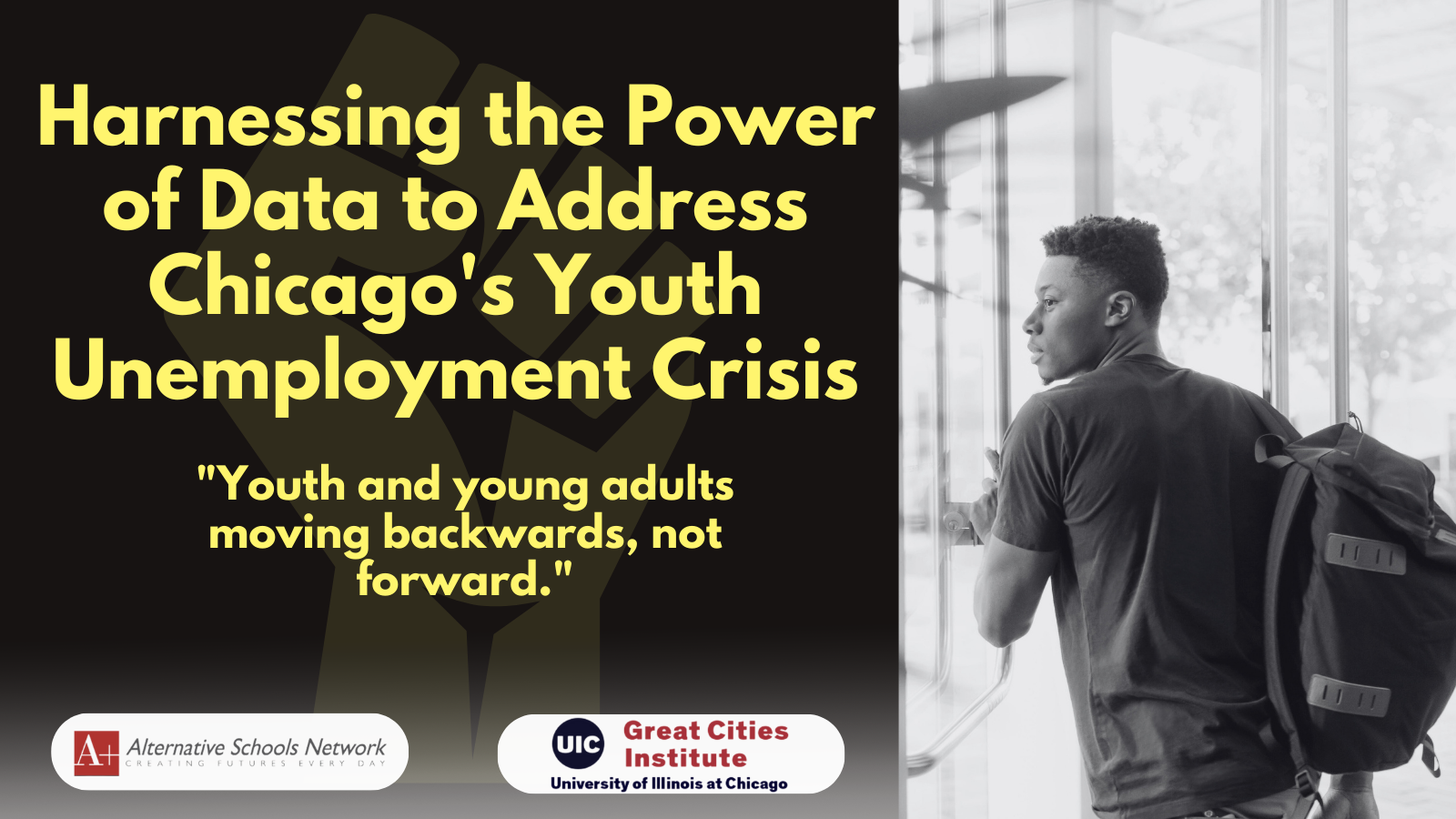County Commissioner Gainer Hearing Zeros in on Disconnected Youth Crisis
COUNTY COMMISSIONER GAINER HEARING ZEROS IN ON DISCONNECTED YOUTH CRISIS
New Report Shows Cook County Worst in Nation for Black 20-24 Year Olds Out of School & Out of Work
CHICAGO – The numbers in a new University of Illinois at Chicago Great Cities Institute (GCI) report, A Lost Generation: The Disappearance of Teens and Young Adults from the Job Market in Cook County, tell a tragic and alarming story about a generation of Black and Hispanic young people being left behind as the employment programs that could help them catch up remain severely underfunded by government at every level.
“Across all employment indicators, for 20-24 year olds, Whites in Cook County fare better than all other groups including Whites in Illinois, the U.S. and counties containing New York City, Los Angeles and Houston,” said the report, using 2014 data. “Conversely, Blacks in Cook County in comparison to all groups across all geographies have the highest rates of joblessness as well as the highest rates of those out of school and out of work.”Â
Triggered by GCI’s earlier report, Lost: The Crisis of Jobless and Out Of School Teens and Young Adults in Chicago, Illinois and the U.S., Cook County Commissioner Bridget Gainer submitted a resolution for a hearing.
“We cannot let another summer go by with thousands of teenagers without jobs, and the skills that come with work,” Gainer said. “The report is clear – a lack of jobs for youth equals a lost opportunity to invest in our city.”Â
The resolution, calling for a discussion of the report’s “findings … on youth joblessness,” was co-sponsored by fellow Commissioners Richard R. Boykin, Robert Steele, Deborah Simms, John Daley, Joan Murphy and Jesus Garcia. That led to the Tuesday, March 22 hearing, entitled, “Nothing Stops a Bullet Like a Job” convened by the Cook County Board’s Workforce, Housing and Community Development Committee and chaired by Gainer.
A coalition of Chicagoland non-profit organizations is organizing a multipronged drive to restore funding for youth employment programs, raise awareness of the crisis and stimulate debate on how to address youth joblessness. The hearing provided a public forum for them to air the grim findings in the new report and speak out about the consequences of allowing the crisis of unemployment among Cook County youths to fester.
“…(J)oblessness leads to poverty, drug abuse, homelessness and violence in our communities,” noted the Cook County Board resolution that set up the committee hearing. “(T)he persistence and severity of these conditions have ramifications for our young people and generations to come,” wrote the new study’s authors.
Requested by the Alternative Schools Network (ASN) and developed by the University of Illinois at Chicago’s Great Cities Institute (GCI), the new report shows that teens and young adults in Cook County are in the same dire straits as Chicago’s inner-city youths. The earlier report, released by GCI in January, compared employment levels for young people in Chicago, New York and Los Angeles. Inner-city teens and young adults in Chicago were worse off than those in the other two major cities.
“If we want to stop the violence that has swept through our communities, we have to start with getting our young people off the streets and into the workplace,” said ASN Executive Director Jack Wuest. “We are exploring every route possible to increase funding for youth job programs. We are working to get the private sector involved. We are working to get city, state and federal government funding. For those in public office who say the government can’t afford to fund these programs, we say, ‘the government can’t afford not to get our young people working.”Â
JOBS ARE SCARCE FOR MINORITY YOUTHS THROUGHOUT COOK COUNTY
The new report shows Cook County youths, but especially Black and Hispanic males, are experiencing the same crisis as those in Chicago:
For 20 – 24 year olds in Cook County:
- Male, female disparities: In Cook County, for all groups, males had higher percentages of out of school and out of work than females, although the gap was highest between black males and females. Cook Co. Youth Jobless Report News Release 3/31/16 Page 2 of 2
- Black/White gap severe: The largest percentage gap across all geographies in 2014 was between Blacks and Whites in Cook County, where the employment-population ratio was 29.1 percentage points higher for the White population.
For 16 to 19 year olds in Cook County:
- Across the board increases in joblessness: Increases in joblessness between 2005 and 2014 occurred across all race/ethnic groups though most dramatically for Whites.
- Blacks & Hispanics males trail Whites: In Chicago a staggering 88.5 percent of Black males 16-19 and 87.4 percent of Hispanic males were jobless in 2014. Youths that age aren’t doing much better in Cook County as a whole, where 87 percent of 16-19 year-old Black males and 78 percent of Hispanics 16-19 were unemployed, compared to 74 percent of White teens.
For 20-24 year olds:
- Cook County mirrors Black Chicago experience: 39.5 percent of Blacks were out of school and out of work in Cook County, closely mirroring the 40.9 percent of Chicagoans in that age group that were similarly disconnected.
- Joblessness up for Blacks, down for Whites and Hispanics: Comparing the data from 2005 and 2014, joblessness went down for Whites and Latinos but up for Blacks.
- Hispanic employment lower in Illinois than in U.S.: Hispanic employment rates were lower in Cook County than Hispanic employment rates in Illinois and the U.S. in 2005 and 2014.
LOCATION, LOCATION, LOCATION
“In viewing Cook County, the starkest comparisons exist when we compare the South suburbs to the north suburbs,” the new report said.
- North’s employment rate double South’s: For 20-24 year olds, for example, employment-to-population ratios in North suburbs were more than twice as high as ratios in the south suburbs.
- Joblessness correlates with race: In Chicago, Community Areas with 40.1 percent to 60.0 percent and 60.1 percent to 80.0 percent of jobless rates were remarkably similar to the areas with over 90 percent black populations among the 18 to 24 year-olds population.
- Out-of-school, out-of-work highest in South suburbs: Southern Cook County, just south of the Chicago boarder, has an out of school and out of work rate of 40.8 percent for those aged 20-24, the highest in Cook County outside of Chicago.
- Youths in far north Cook areas fare the best: The areas on the northern border of Cook County had the lowest rates of out of school and out of work 20 to 24 year olds with rates of 7.4, 9.1 and 9.2 percent.
Those testifying at the hearing:
- Young people who have struggled to find work
- The Reverend Michael Pfleger, the Faith Community of St. Sabina
- The Reverend Father Dave Kelly, Precious Blood Ministries
- Teresa Córdova, Director, Great Cities Institute, University of Illinois at Chicago
- Kelly Hallberg, PhD, Scientific Director, University of Chicago Crime Lab
- Karin M. Norington-Reaves, CEO, Chicago Cook Workforce Partnership
- Mary Ellen Messner, Deputy Commissioner, Chicago Department of Family and Support Services
- Quiwana Bell, Chief Operating Officer, Westside Health Authority
- Andrew Wells, Director, Workforce Development Center, Chicago Urban League
- David Whittaker, Executive Director, Chicago Area Project
- Andre Cosey, Case Manager, Metropolitan Family Services
- Rachel Bhagwat, Community Engagement Coordinator, La Casa Norte
- Berto Aguayo, Senior, Dominican University, Mikva Challenge
- Kimberly Hopson, Resource Coordinator, Youth Connection Charter School
- Nkrumah English, Program Office, Black United Fund of Illinois
- Therese McMahon, Director of Training and Advancement, A Safe Haven Foundation
- Jack Wuest, Executive Director, Alternative Schools Network
ABOUT THE ALLIANCE FOR YOUTH JOBS Organizations who helped organize the hearing include ASN, Chicago Urban League, Westside Health Authority, Chicago Area Project, Black United Fund of Illinois, Mikva Challenge, Metropolitan Family Services, Youth Connection Charter School, A Safe Haven Foundation, the Latino Policy Forum and La Casa Norte. The hearing was held at the Cook County Board Room. In addition to Gainer, Commissioners Deborah Sims, Jeffrey R, Tobolski, Larry Suffredin and Richard R. Boykin serve on the committee. For a complete copy of the report: https://greatcities.uic.edu/2016/03/21/a-lost-generation-the-disappearance-of-teens-and-young-adults-from-thejob-market-in-cook-county





